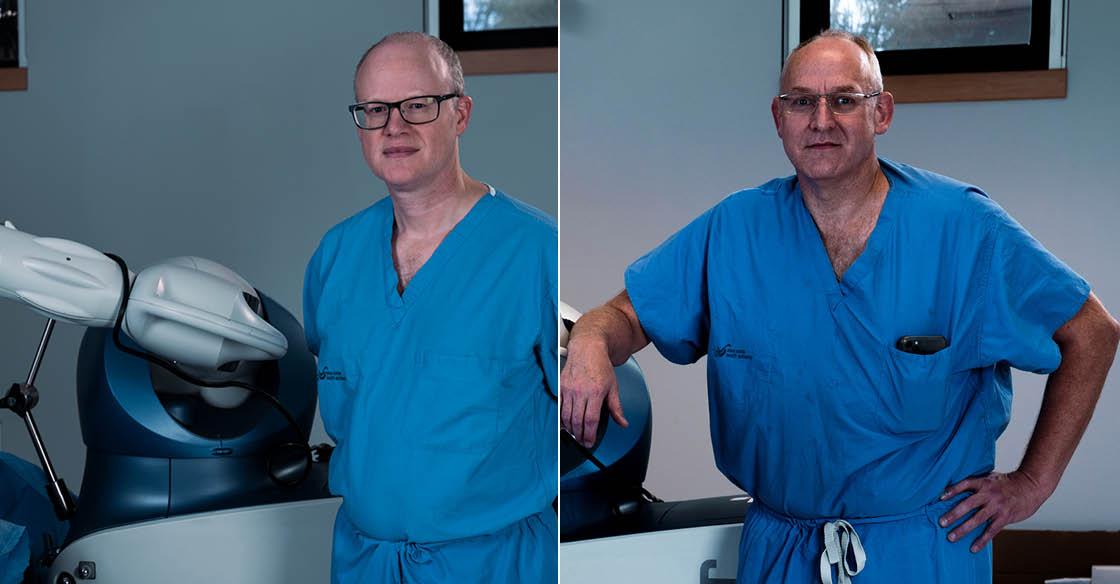
Pictured: QEII orthopaedic surgeons, Dr. Glen Richardson (left) and Dr. Michael Dunbar. Article originally published via The Chronicle Herald.
Set to be entirely funded by QEII Foundation donors, the QEII's new orthopaedic robot unlocks custom joint replacements tailored just for you.
The human body is as unique as a fingerprint, and the arrival of robotic surgeries means more patients at Nova Scotia Health’s QEII Health Sciences Centre are receiving surgeries tailored just for them.
Surgeons Dr. Michael Dunbar and Dr. Glen Richardson have spent the last few months studying, practicing and getting to know the QEII’s first orthopaedic robot, known as the Mako System. Nova Scotia Health’s Innovation team worked with the technology supplier and the orthopaedic clinical team to make this acquisition a reality.
With robot-assisted orthopaedic surgeries – beginning with partial and total knee replacements and eventually hip joint replacements – starting this fall, the QEII Foundation is actively fundraising in support of this game-changing technology, the second of its kind in all of Canada. The $2.5-million project will be entirely donor-funded.
“It’s like a suit — not everyone can buy off the rack,” says Dr. Dunbar. “I’m excited because the robot gives me the ability to start thinking about how people are different and how would I tailor my surgical approach to the individual as opposed to one approach fits all.”
Traditional knee and hip replacement surgeries are still world-class procedures and will continue to be performed by surgeons like Dr. Richardson and Dr. Dunbar at the QEII. Each patient’s unique orthopaedic fingerprint and health data will help determine which patients undergo a robotic procedure and which go the traditional route.
In both cases, the surgeon takes the lead. The orthopaedic surgical robot adds an extra level of precision that go beyond what any human-guided tools can do.
“We now have the ability to plan three-dimensionally because we're basing the surgery off of 3D CT scans,” says Dr. Dunbar. “At the time of surgery, or even before surgeries, we’re able to take a computer model of the prosthesis (man-made joint) and superimpose it on the end of the bone, creating a guide … and boundary limits for the tip of the saw, which shuts off the moment it comes outside the guides.”
The customized approach to each surgery can positively impact patient outcomes. With the precision of the orthopaedic robot, patients can experience less bleeding, less pain, less soft tissue trauma and shorter recovery times.
“We're now in a position to say that, when I do understand that your anatomy is slightly different, then we can put the (hip or knee) component precisely where we think it should go,” says Dr. Dunbar.
Dr. Richardson adds that while surgeries have always been tailored to the patient to the greatest extent possible, the precision of the robotic tool allows surgeons and their colleagues to go even further.
“This is just going to be one part of a greater plan for us to help predict how patients do,” says Dr. Richardson. “Everyone is so unique, and everyone brings different things to the table; and we'll be able to consider all those parameters and use that information to help guide us and allow the tool to implement that particular operation.”
Using knee replacements as an example, the traditional approach to these surgeries was to make every knee straight, even though many people walk around slightly bow-legged. Determining exactly what angles and fit will produce the best outcome for each patient, is where both surgeons see potential.
“The real question then becomes should I reproduce what they were born with, or should I put them into a neutral position that’s straight, which is the philosophy we’ve taken for a long time, because it was easier to do it that way with manual instruments,” says Dr. Dunbar.
While knee and hip joint replacement surgeries have recurring positive patient outcomes, both doctors say some still struggle with their replacements — something the orthopaedic robot has potential to change. In these cases, patients most often require a follow-up surgery known as a revision.
“One of our goals is to reduce the number of revisions needed,” says Dr. Richardson. “Robots are extremely accurate in terms of where the implants are going, so what we’re measuring is really what happens in the surgery. We’ll be able to go back, look at how patients do with the operation and use that information as feedback and better understand how we might position things a little differently for these patients going forward.”
As researchers, it’s the long-term data and long-term patient outcomes they remain most curious about. They say it’s only a matter of time before robotic-assisted surgeries become more commonplace in the Maritimes. In the short-term, the arrival of the orthopaedic robot is also drawing talent from the broader surgical and health research communities. With donor support, the initiative will set care standards on a global stage.
“There's no field that robotics has entered that it hasn’t improved,” Dr. Dunbar says. “I think a lot about the intersection for example how we introduce robotics, but at the same time maintain the humanity of medicine.”
To support the QEII Foundation’s fundraising and help make a life-changing impact on orthopaedic patients in Atlantic Canada, donate at QE2Foundation.ca/orthorobot or 902 334 1546.